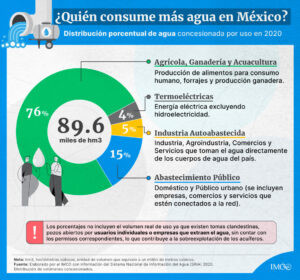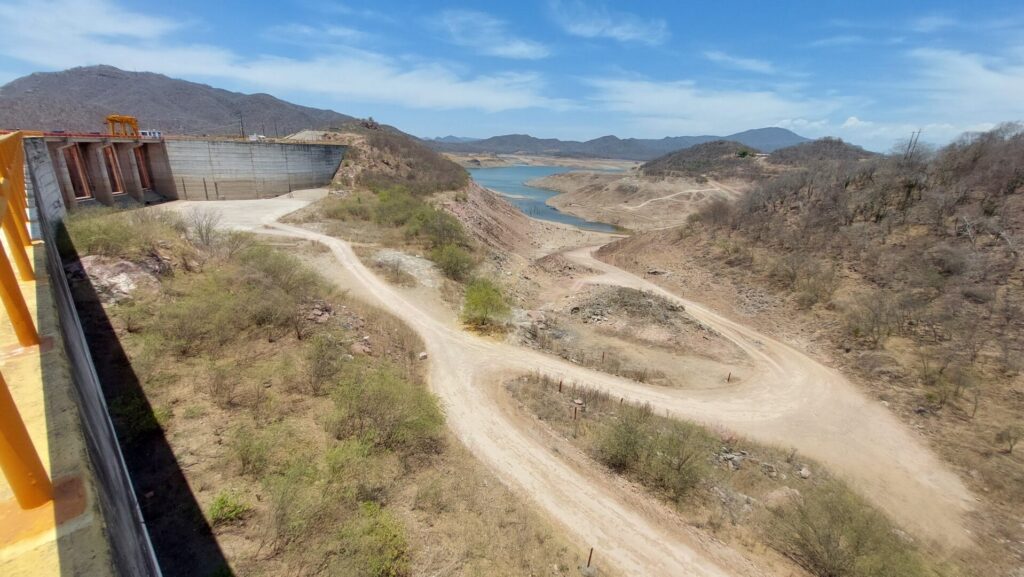This Wednesday, March 22, marks the commemoration of the World Water DayBut did you know that due to rising temperatures, overexploitation of aquifers and problems in the distribution network, contamination and lack of control of concessions, Mexico has faced problems of drought that in recent years have become more recurrent, extreme and long-lasting?
According to data from the World BankIn Mexico, the average annual availability per capita went from 10,000 cubic meters (m3) in 1960 to 4,000 in 2012. It is estimated that by 2030, this availability in Mexico will drop below 3,000 m3 per inhabitant per year, the analysis highlights.
In a research conducted by the Mexican Institute for CompetitivenessOf the 100% of water concessioned in the country, three quarters goes to the agricultural sector, 15% is for public supply, 5% goes to industry and 4% for the operation of thermoelectric power plants.

"To guarantee future demand, the Mexican State needs to update the legal and regulatory frameworks that govern water management, as well as modernize the country's hydraulic infrastructure. It is necessary to take into consideration the different technical characteristics, particularly geophysical, and challenges that the country currently presents in terms of water, such as population growth, urban sprawl, the evolution of droughts, as well as the variation in rainfall," states IMCO..
Surface water and pollution
In Mexico, the 71% from the surface water is in the central and southern areas of the country and the remaining 29% in the north. The main problem faced by these bodies of water is the contaminationThe main source of wastewater, whether domestic, industrial, agricultural or livestock, which in most cases is discharged without prior treatment and contains dissolved pollutants and contaminants. It should be noted that 60% of the water that is made potable in Mexico comes from these bodies of water.
Overexploited aquifers
IMCO's research reveals that in 2018, 18% of the subway aquifers were overexploited, affecting not only the availability of water for human consumption, but also for agricultural and industrial activities.
In addition, 5% of the aquifers had problems of soil salinization, a process that increases the concentration of salts and minerals in groundwater and deteriorates its quality parameters, and 3% already has problems of marine intrusion, which occurs when salt water inland displaces fresh water.
Rainfall versus drought
On average, Mexico receives approximately 1.5 million cubic hectometers of water per year, 67% of this rainfall falls between June and September, but half of it in the south-southeast region.
Although average annual precipitation at the national level has increased over time, potentially due to the climate changeThis phenomenon has not occurred in all states.
Meanwhile, 52% of Mexico's territory (14 states) is located in arid or semi-arid climates. In these states, drought problems have been recurrent and in the last decade have increased in frequency, intensity and duration. In 2021 alone, 8,491 droughts were recorded, of which 71% were severe, with risk of crop losses; 26% were extreme, with major crop losses and risk of forest fires, and 3% were exceptional, i.e. with total water shortages in reservoirs, streams and wells.
Proposals to address the problem
IMCO stresses that, given this problem, Mexico must make decisions on water management based on data and evidence, and proposes four ideas that address this issue from the angles of regulation, infrastructure and management.
- Improve the monitoring of water use, mainly in the livestock and agricultural sector, since it is currently not based on precise measurements, but on estimates, with the objective of having data and indicators that allow for more efficient water management in the country.
- Develop climate projects in the livestock and agriculture sector, for example, through the purchase and sale of carbon credits or climate finance such as the Green Climate Fund (GCF). It is essential to develop infrastructure for water management.
- Evaluate and update the delimitation of the aquifers into which the country is divided using geophysical rather than geopolitical criteria.
- Invest in infrastructure modernization and conservation. Mexico needs to improve its water infrastructure for more efficient management, mainly to address the problem of clandestine connections and leaks.
Source: IMCO


